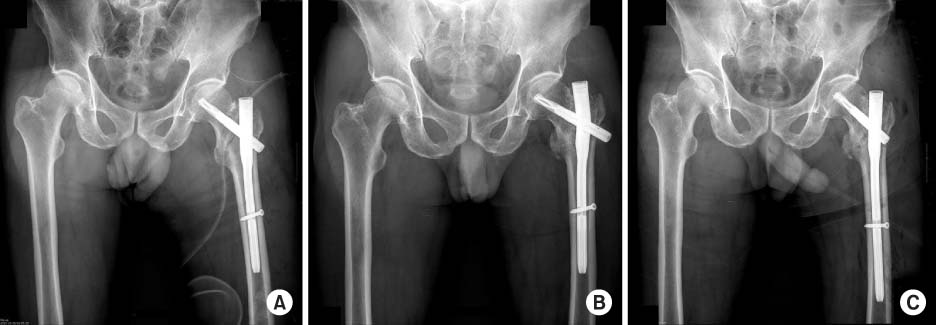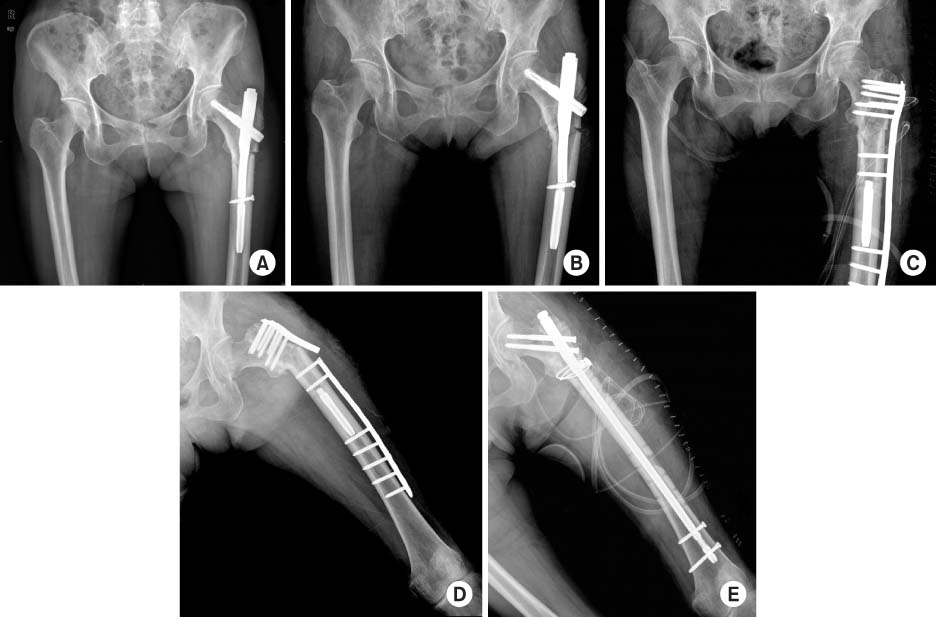J Korean Fract Soc.
2014 Oct;27(4):315-320. 10.12671/jkfs.2014.27.4.315.
Removal Methods for Broken Proximal Femoral Nails Using Ball Tip Guide Wire: Technical Note and Two Cases Report
- Affiliations
-
- 1Department of Orthopedic Surgery, Gwangju Veterans Hospital, Gwangju, Korea. chm1228@naver.com
- KMID: 2015488
- DOI: http://doi.org/10.12671/jkfs.2014.27.4.315
Abstract
- Recently, the use of intramedullary nailing for proximal femoral fractures has increased. Breakage of the nail usually occurs at the un-united fracture site, and it is a rare complication of intramedullary nailing of the femur. However, removal of the distal fragment of a broken nail is a challenging problem. Herein, the authors describe the methods used for removal of relatively fixed or strongly fixed broken intramedullary nails in two different cases.
Keyword
Figure
Cited by 1 articles
-
Breakage of the Tail Portion of the Lag Screw during Removal of Proximal Femoral Zimmer Natural Nail: Report of Two Cases with Technical Notes
Asep Santoso, Ik-Sun Choi, Kyung-Soon Park, Taek-Rim Yoon
Hip Pelvis. 2017;29(3):199-203. doi: 10.5371/hp.2017.29.3.199.
Reference
-
1. Poehling GG, Webb LX. Retrieval and replacement of a broken Küntscher rod by a closed technique. Technical note. J Bone Joint Surg Am. 1982; 64:1389–1390.
Article2. Brewster NT, Ashcroft GP, Scotland TR. Extraction of broken intramedullary nails--an improvement in technique. Injury. 1995; 26:286.
Article3. Kim DS, Kwon CS, Ahn JK, et al. Simple method for the extraction of the broken intramedullary nail of femur: case report. J Korean Orthop Assoc. 1999; 34:1171–1174.
Article4. Park SY, Yang KH, Yoo JH. Removal of a broken intramedullary nail with a narrow hollow. J Orthop Trauma. 2006; 20:492–494.
Article5. Magu NK, Sharma AK, Singh R. Extraction of the broken intramedullary femoral nail--an innovative technique. Injury. 2004; 35:1322–1323.
Article6. Georgilas I, Mouzopoulos G, Neila C, Morakis E, Tzurbakis M. Removal of broken distal intramedullary nail with a simple method: a case report. Arch Orthop Trauma Surg. 2009; 129:203–205.
Article7. Karladani AH. Removal of a broken nail using a guide wire and a screw. Acta Orthop. 2006; 77:986–988.
Article8. Lee M, Yang KH. Removal of a broken intramedullary nail with a narrow hollow using a bulb-tipped guide wire and kirschner wire: a case report. J Korean Fract Soc. 2010; 23:377–381.
Article
- Full Text Links
- Actions
-
Cited
- CITED
-
- Close
- Share
- Similar articles
-
- Removal of a Broken Intramedullary Nail with a Narrow Hollow Using a Bulb-tipped Guide Wire and Kirschner Wire: A Case Report
- Removal of Broken Screws of Interlocking Nail: technical note
- Study on the Removal of Segmentally Broken Interlocking Screw in Intramedullary Nail
- A Broken J-Guide Wire during Central Venous Catheterization : A case report
- Percutaneous Interlocking Intramedullary Nailing of Femoral Shaft Fracture with Retrograde Guide Wire Insertion Technique





